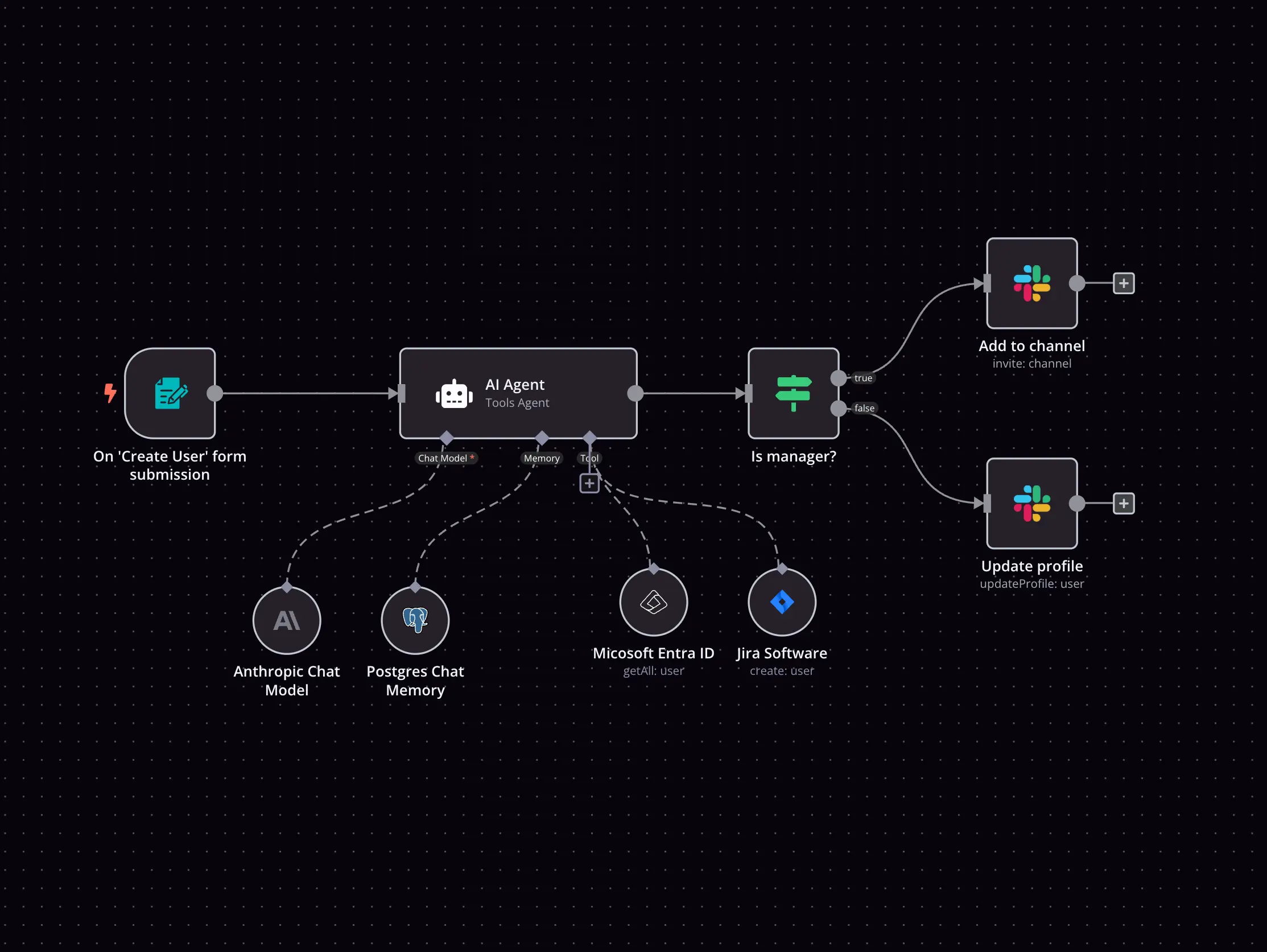Auth0 Management API and Flotiq integration




How to connect Auth0 Management API and Flotiq
Create a new workflow and add the first step
In n8n, click the "Add workflow" button in the Workflows tab to create a new workflow. Add the starting point – a trigger on when your workflow should run: an app event, a schedule, a webhook call, another workflow, an AI chat, or a manual trigger. Sometimes, the HTTP Request node might already serve as your starting point.
Build your own Auth0 Management API and Flotiq integration
Create custom Auth0 Management API and Flotiq workflows by choosing triggers and actions. Nodes come with global operations and settings, as well as app-specific parameters that can be configured. You can also use the HTTP Request node to query data from any app or service with a REST API.
Supported API Endpoints for Auth0 Management API
Get a user
Retrieve a user by their ID.
Create a user
Create a new user.
Delete a user
Delete a user by their ID.
Update a user
Update a user's information.
Search users
Search for users based on specific criteria.
Get a client
Retrieve a client by its ID.
Create a client
Create a new client.
Delete a client
Delete a client by its ID.
Update a client
Update a client's information.
List all clients
Retrieve all clients.
Get a connection
Retrieve a connection by its ID.
Create a connection
Create a new connection.
Delete a connection
Delete a connection by its ID.
Update a connection
Update a connection's information.
List all connections
Retrieve all connections.
Get a role
Retrieve a role by its ID.
Create a role
Create a new role.
Delete a role
Delete a role by its ID.
Update a role
Update a role's information.
List all roles
Retrieve all roles.
To set up Auth0 Management API integration, add the HTTP Request node to your workflow canvas and authenticate it using a predefined credential type. This allows you to perform custom operations, without additional authentication setup. The HTTP Request node makes custom API calls to Auth0 Management API to query the data you need using the URLs you provide.
See the example hereThese API endpoints were generated using n8n
n8n AI workflow transforms web scraping into an intelligent, AI-powered knowledge extraction system that uses vector embeddings to semantically analyze, chunk, store, and retrieve the most relevant API documentation from web pages. Remember to check the Auth0 Management API official documentation to get a full list of all API endpoints and verify the scraped ones!
Supported API Endpoints for Flotiq
List content types
Retrieves a list of all content types available.
Create content type
Creates a new content type.
Update content type
Updates an existing content type.
Get single content type
Retrieves details of a specific content type.
Delete content type
Deletes a specific content type.
Create content type
Create a new content type definition.
Get content type
Retrieve a specific content type definition.
Update content type
Update an existing content type definition.
Delete content type
Delete an existing content type definition.
Create content type
Creates a new content type for the application.
Update content type
Updates an existing content type in the application.
List content types
Retrieves a list of all content types available in the application.
Get single content type
Retrieves a specific content type by its ID.
Delete content type
Deletes a specified content type from the application.
Create content type
Creates a new content type definition via API.
Update content type
Updates an existing content type definition.
List content types
Retrieves a list of content type definitions.
Get single content type
Retrieves a single content type definition by ID.
Delete content type
Deletes a specific content type definition by ID.
List content objects
Retrieves a list of all content objects.
Create content object
Creates a new content object.
Update content object
Updates an existing content object.
Get single content object
Retrieves details of a specific content object.
Delete content objects
Deletes a specific content object.
Create content object
Creates a new content object in the application.
Update content object
Updates an existing content object in the application.
List content objects
Retrieves a list of all content objects available in the application.
Get single content object
Retrieves a specific content object by its ID.
Delete content object
Deletes a specified content object from the application.
List deleted content objects
Retrieves a list of all deleted content objects.
Create content object
Creates a new content object based on a content type.
Update content object
Updates an existing content object.
List content objects
Retrieves a list of content objects.
Get single content object
Retrieves a single content object by ID.
Delete content object
Deletes a specific content object by ID.
Retrieve content object
Retrieve the schema of a specific Content Object by sending a GET request.
Delete content object
Delete a specific Content Object identified by its ID.
Retrieve GraphQL schema
Retrieve the GraphQL schema that describes your data.
Execute GraphQL queries
Execute GraphQL queries to retrieve specific data.
Get blogposts
Retrieve details of blogposts content type.
Create content type
Create a new Content Type Definition in the system.
Update content type
Updates the definition of the specified content type using a PUT request.
Update blogposts
Updates the schema definition for blog posts.
To set up Flotiq integration, add the HTTP Request node to your workflow canvas and authenticate it using a generic authentication method. The HTTP Request node makes custom API calls to Flotiq to query the data you need using the API endpoint URLs you provide.
These API endpoints were generated using n8n
n8n AI workflow transforms web scraping into an intelligent, AI-powered knowledge extraction system that uses vector embeddings to semantically analyze, chunk, store, and retrieve the most relevant API documentation from web pages. Remember to check the Flotiq official documentation to get a full list of all API endpoints and verify the scraped ones!
Auth0 Management API and Flotiq integration details

Auth0 Management API
Auth0 Management API is a tool for developers to manage and configure their Auth0 identity and access management service programmatically. It allows for user management, access control, and other administrative tasks through API calls.
Auth0 Management API credentials docs
Using predefined credential types
See Auth0 Management API integrations
Related categories
The SOAR platform you want
Mountains of monotonous tasks make building and monitoring your workflows a chore. Not anymore.
Learn more
Save engineering resources
Reduce time spent on customer integrations, engineer faster POCs, keep your customer-specific functionality separate from product all without having to code.
FAQ
Can Auth0 Management API connect with Flotiq?
Can I use Auth0 Management API’s API with n8n?
Can I use Flotiq’s API with n8n?
Is n8n secure for integrating Auth0 Management API and Flotiq?
How to get started with Auth0 Management API and Flotiq integration in n8n.io?
Looking to integrate Auth0 Management API and Flotiq in your company?
The world's most popular workflow automation platform for technical teams including
Why use n8n to integrate Auth0 Management API with Flotiq
Build complex workflows, really fast
